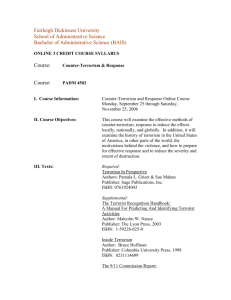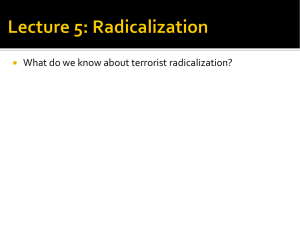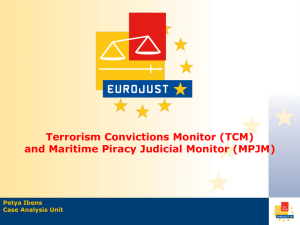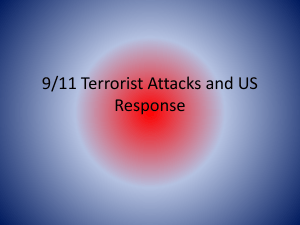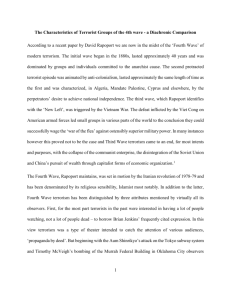Foreign Minister Alexander Downer, portrayed the threat of terrorism
advertisement
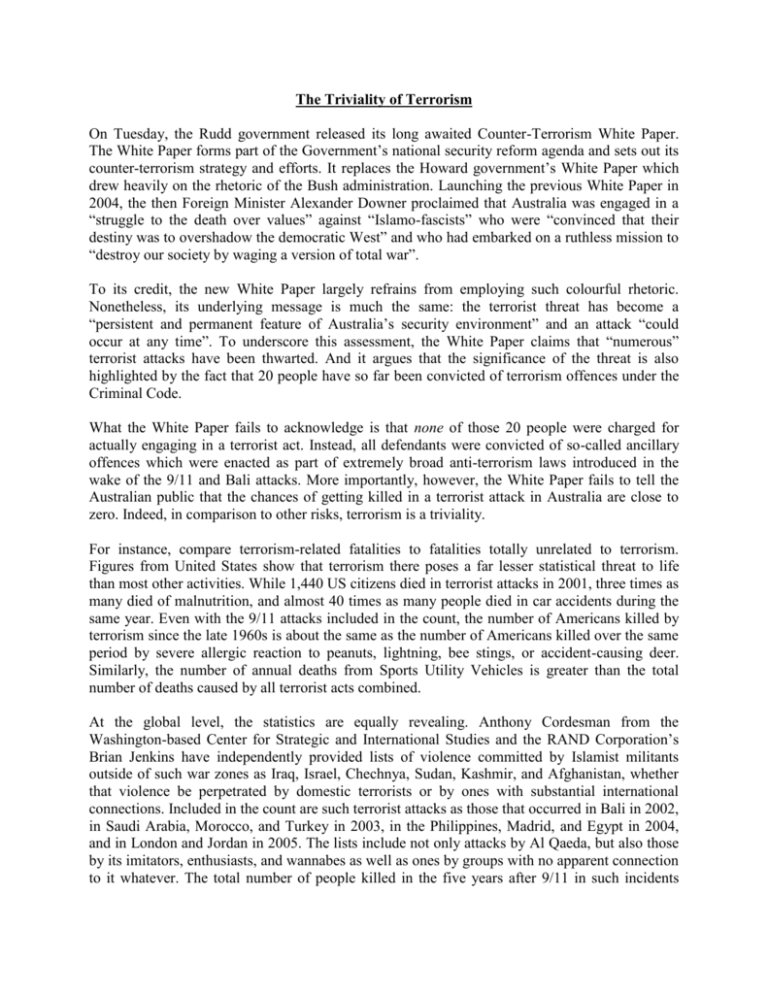
The Triviality of Terrorism On Tuesday, the Rudd government released its long awaited Counter-Terrorism White Paper. The White Paper forms part of the Government’s national security reform agenda and sets out its counter-terrorism strategy and efforts. It replaces the Howard government’s White Paper which drew heavily on the rhetoric of the Bush administration. Launching the previous White Paper in 2004, the then Foreign Minister Alexander Downer proclaimed that Australia was engaged in a “struggle to the death over values” against “Islamo-fascists” who were “convinced that their destiny was to overshadow the democratic West” and who had embarked on a ruthless mission to “destroy our society by waging a version of total war”. To its credit, the new White Paper largely refrains from employing such colourful rhetoric. Nonetheless, its underlying message is much the same: the terrorist threat has become a “persistent and permanent feature of Australia’s security environment” and an attack “could occur at any time”. To underscore this assessment, the White Paper claims that “numerous” terrorist attacks have been thwarted. And it argues that the significance of the threat is also highlighted by the fact that 20 people have so far been convicted of terrorism offences under the Criminal Code. What the White Paper fails to acknowledge is that none of those 20 people were charged for actually engaging in a terrorist act. Instead, all defendants were convicted of so-called ancillary offences which were enacted as part of extremely broad anti-terrorism laws introduced in the wake of the 9/11 and Bali attacks. More importantly, however, the White Paper fails to tell the Australian public that the chances of getting killed in a terrorist attack in Australia are close to zero. Indeed, in comparison to other risks, terrorism is a triviality. For instance, compare terrorism-related fatalities to fatalities totally unrelated to terrorism. Figures from United States show that terrorism there poses a far lesser statistical threat to life than most other activities. While 1,440 US citizens died in terrorist attacks in 2001, three times as many died of malnutrition, and almost 40 times as many people died in car accidents during the same year. Even with the 9/11 attacks included in the count, the number of Americans killed by terrorism since the late 1960s is about the same as the number of Americans killed over the same period by severe allergic reaction to peanuts, lightning, bee stings, or accident-causing deer. Similarly, the number of annual deaths from Sports Utility Vehicles is greater than the total number of deaths caused by all terrorist acts combined. At the global level, the statistics are equally revealing. Anthony Cordesman from the Washington-based Center for Strategic and International Studies and the RAND Corporation’s Brian Jenkins have independently provided lists of violence committed by Islamist militants outside of such war zones as Iraq, Israel, Chechnya, Sudan, Kashmir, and Afghanistan, whether that violence be perpetrated by domestic terrorists or by ones with substantial international connections. Included in the count are such terrorist attacks as those that occurred in Bali in 2002, in Saudi Arabia, Morocco, and Turkey in 2003, in the Philippines, Madrid, and Egypt in 2004, and in London and Jordan in 2005. The lists include not only attacks by Al Qaeda, but also those by its imitators, enthusiasts, and wannabes as well as ones by groups with no apparent connection to it whatever. The total number of people killed in the five years after 9/11 in such incidents came to around 200-300 per year. By comparison, over the same period far more people have perished in the United States alone in bathtub drownings. In Australia, the statistics tell a similar story. To date, not a single person has been killed in a terrorist attack on Australian soil in the post-9/11 era. Around 100 Australians have died in terrorist attacks overseas, most of them in the Bali bombings of October 2002. A calculation of annual fatality risks for the period of 1970-2007 reveals that the risk of getting killed in a terrorist attack in Australia is 1 in 33,300,000. Even with the Bali bombings included, the fatality risk stands at 1 in 7,100,000. By comparison, the risk of getting killed in a traffic accident amounts to 1 in 15,000. Yet, many Australian highways remain in a shocking condition. The Government’s response to terrorism, on the other hand, has been gigantic. Since 2001, Australia’s total defence spending has increased 59 per cent from $13.7 billion to $21.8 billion. More than $16 billion have been spent in extra defence, counter-terrorism and foreign aid by 2010-11. Over the same period, ASIO’s budget has increased by 655 per cent, the Australian Federal Police (AFP) budget by 161 per cent, ASIS by 236 per cent and the Office of National Assessments by 441 per cent. Most recently, the Government has announced a $200 million package of aviation security measures to better protect our air transport system from terrorist attack. And the White Paper provides $69 million for introducing biometric-based visa systems to reduce the risk of terrorists, criminals and other persons of concern entering Australia undetected. The legislative response has been unprecedented, too. Parliament has enacted more than 40 pieces of “security legislation” since 9/11 which ensure that Australia has some of the most draconian anti-terrorism laws in the Western world. In contrast to the US, the UK and Canada, Australia’s domestic intelligence agency, ASIO, was given unprecedented powers to detain persons not suspected of any offence for up to seven days without charge or trial. The AFP was given extensive stop and search powers and may apply for control and preventative detention orders. Australia’s criminal law and procedure has seen radical changes, too. These include, among other things, the introduction of an overly broad definition of “terrorist act”, the reversal of the presumption in favour of bail in terrorism-related cases, and executive powers to proscribe (and criminalise) organisations considered to be “terrorist”. The Rudd government deserves credit for issuing a new Counter-Terrorism White Paper. It is regrettable however, that the Government continues to sell terrorism as a defining threat to Australia’s security. Nine years after 9/11 – and with no terrorism attack having occurred on Australian soil – it is time for a comprehensive and facts-based review and reform of Australia’s approach to counter-terrorism. This process should have started with the realisation that the risk of terrorism in Australia is insignificant. Chris Michaelsen is the Co-Director of the International Law & Policy Group at the Faculty of Law, UNSW.
